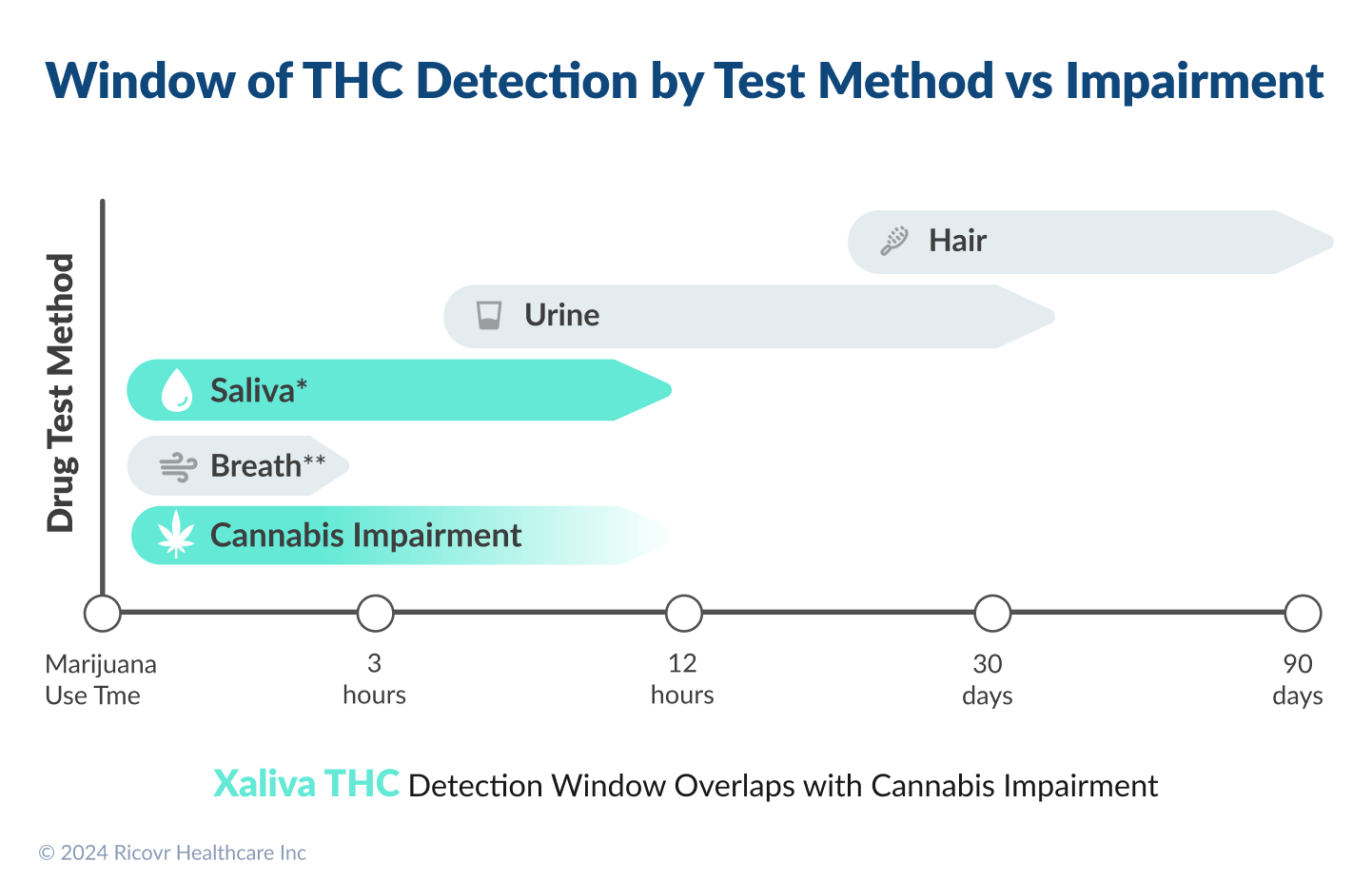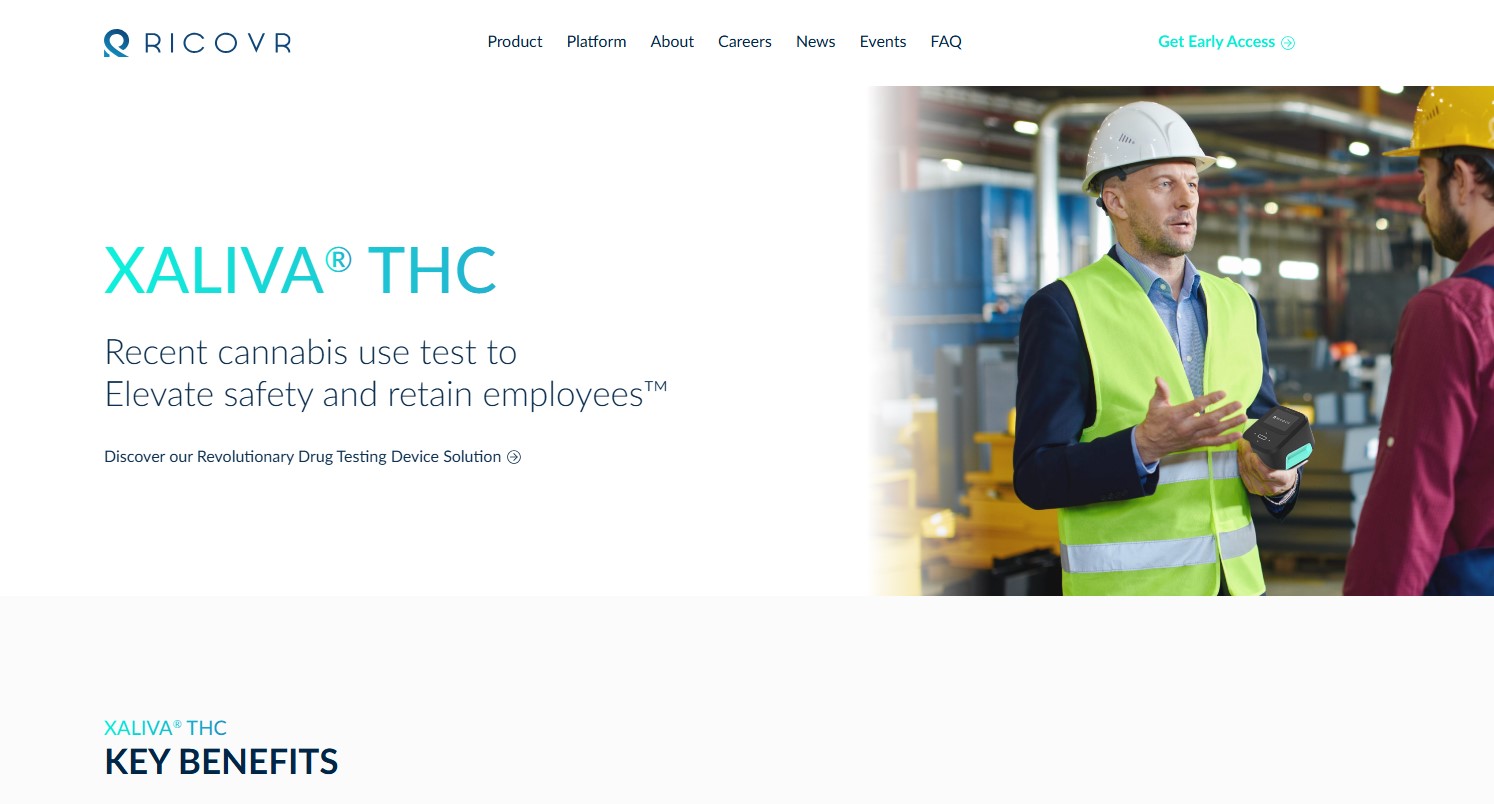Advantages of Saliva Marijuana Drug Testing

Which method provides the optimal detection length to identify Recent Cannabis (THC) use?
A recent study from the University of California San Diego measured the concentration of Cannabis or Tertrahydorcanbinol (THC )in blood and saliva over 5.5 hours post-smoking. The authors noted that concentrations of THC were more variable in blood samples compared to saliva, “supporting improved utility for saliva drug testing.” THC continued to be detectable in saliva at 4.4 hours post-smoking in 87.5% of participants, while half had fallen below a 5 ng/mL cut-off by that time. (1) This finding demonstrates the ability of saliva to provide detection at specified cut-off levels to achieve the desired detection window. The same study found that “Breath was an excellent biomarker of use within the first 40 min post-smoking. After this time, most participants had undetectable concentrations, and the utility of THC in breath as a biomarker was diminished.” (1) This finding shows that breath testing may only have a 40-minute detection window, and the window of THC impairment is 3-to-10 hours, according to the most comprehensive impairment research from Neuroscience & Biobehavioral Reviews. (2) Therefore, detection window for breath testing is too short and could lead to adverse safety outcomes if implemented in workplaces and communities. In addition, currently, there are no products on the market that accurately test breath and are commercially available for employers.
Depending on the THC cut-off level, saliva testing can detect THC over a more extended period of time and detect THC for the entire window of potential impairment, whereas breath cannot. As depicted in Fig 1 below.
What does independent clinical research say about Breath vs. Saliva marijuana (THC) drug testing?
When detected using the same laboratory methods, saliva contained 1000x more THC, the psychoactive component of marijuana, than breath. Four hours after using cannabis, THC was undetectable in breath but continues to be measurable in saliva. (1,3) A new federally funded study with the National Institute of Standards and Technology (NIST) and the University of Colorado Boulder found that even when using carefully collected breath samples and laboratory analysis, researchers found THC levels were too inconsistent to tell whether someone had smoked marijuana recently. “THC was not detected in three post-use breath extracts, and the remainder of post-use extracts were similar to or lower than baseline extracts,” the researchers wrote. These observations, the report continues, “suggest that reproducible breath aerosol collection remains an ongoing challenge.” (4)
Can saliva or breath testing detect cannabis edibles?
Breath testing or cannabis breathalyzers may not be able to detect edibles. These products include gummies, brownies, cookies, and other items. No academic research to date shows that breath testing can effectively detect THC consumed in an edible product. Edibles are the fastest-growing method of cannabis consumption in the U.S. Overall, edibles sales grew by more than 20% from $1.15 billion in 2020 to $1.38 billion in 2021. (5) Saliva, on the other hand, has been shown to detect THC from cannabis edibles in academic research. (6)
What are my options for recent marijuana use (THC) drug testing?
Currently, there are three THC drug testing methods endorsed by the U.S. federal government through the Substance Abuse and Mental Health Services Administration (SAMHSA). Of the three, only one of these methods supports recent-use detection: saliva. (7,8) The Department of Transportation (DOT) recently approved and published a final rule using saliva drug testing on June 1st, 2023. “The scientific basis for the use of oral fluid as an alternative specimen for drug testing has now been broadly established, and the advances in the use of oral fluid in detecting drugs have made it possible for this alternative specimen to be used in Federal programs with the same level of confidence that has been applied to the use of urine.” (9) The optimal THC detection time for workplace drug testing will cover the entire workday. This acts as a deterrent to workplace cannabis use, mitigates safety risks, and provides fairness to legal users who consume on their own time. It requires accurate, easy-to-collect, rapid, on-site technology. Saliva testing is the only method that can meet these requirements.
Learn about our solution, XALIVA® THC, which only detects recent cannabis use within the last 10 hours. For more employer information, please see the following article, Navigating the Complex Landscape of Workplace Drug and Alcohol Testing: A Guide for Employers
Sources:
- https://academic.oup.com/jat/article/45/8/820/6311388#303593226
- https://www.sciencedirect.com/science/article/pii/S0149763421000178
- https://pubmed.ncbi.nlm.nih.gov/22004672/
- https://www.nist.gov/news-events/news/2023/05/researchers-analyze-thc-breath-cannabis-smokers
- https://mjbizdaily.com/led-by-gummies-edibles-keep-pace-with-growth-of-overall-us-marijuana-market/
- https://pubmed.ncbi.nlm.nih.gov/28188235/
- https://www.samhsa.gov/newsroom/press-announcements/201910290830
- https://www.samhsa.gov/sites/default/files/meeting/dtab-program-updates-mandatory-guidelines-062022.pdf
- https://public-inspection.federalregister.gov/2023-08041.pdf



